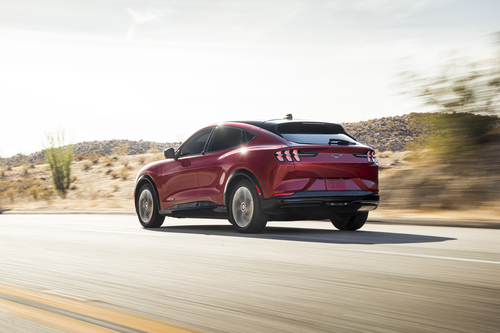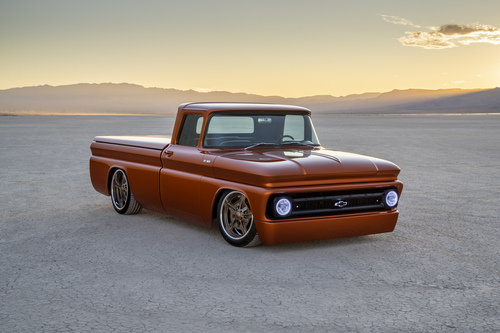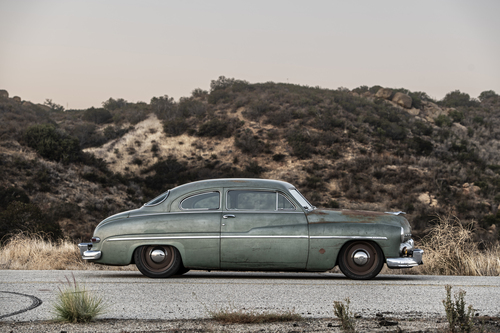BUSINESS
Emerging Vehicle Technologies
Can the Aftermarket Plug and Play in an EV World?
By Mike Imlay

redefine performance for a new era. Ford’s new Mustang Mach-E is
just one example of the advanced vehicle platforms destined to
create new challenges—and opportunities—for the aftermarket.
In January, General Motors (GM) grabbed headlines with the announcement that it planned to be carbon-neutral in both its global products and operations by 2040. A key part of that ambitious goal will be the elimination of tailpipe emissions from its light-duty vehicles by 2035. The automaker said it plans to accomplish that through a heavy $27 billion investment in electric and autonomous vehicles over the next five years. Additionally, GM is committed to offering 30 all-electric vehicle models by mid-decade, with Chevrolet especially at work on eCorvette and electric SUV designs.
GM’s announcement is yet another milestone in the original-equipment manufacturer (OEM) race toward zero emissions, spurred on by advancing fuel economy and CARB regulations, not to mention California’s recently adopted policy goal of phasing out gasoline-powered vehicle sales by 2035. In early 2020, Ford added a Mustang Mach-E GT Performance Edition to its Mach-E stable. The electric-vehicle (EV) pony car pumps out 480 hp (358 kw) and 634 lb.-ft. of torque (860 Nm) to go zero–60 in 3.5 sec. And, while not fully electric, Ford has confirmed it’s rolling out a hybrid Bronco to compete with the Jeep Wrangler 4xe hybrid.
Meanwhile, for vehicle builders, Chevrolet Performance recently debuted the e-crate “Connect and Cruise” concept, using a double-stack electronic motor as a replacement for an original gas engine to yield up to 700 hp. The e-crate engine was teased at the 2019 SEMA Show in project vehicles such as the E-10 restomod ’62 C-10 truck and the eCOPO Camaro, which wowed attendees.
Those are just a few highlights of a much larger picture. In tandem with advanced driver-assistance systems (ADAS) and autonomous vehicle technologies, electrification is adding to the list of disruptive innovations promising to radically reshape the industry.
“I don’t know if there’s ever been a larger shift for our industry, except maybe when it moved from carburetors to fuel injection,” observed Mike Spagnola, SEMA vice president of OEM and product development programs. “You see the amount of money being poured in by the OEs—all chasing the EV market.”
Although Spagnola expects the market for traditional engine and related performance parts to remain viable for some time, the future is certain: Electrification isn’t just coming; it’s here. But rather than spelling the end of an aftermarket era, it presents exciting new opportunities for those ready to capitalize on the trend.

demonstrated at the 2019 SEMA Show with the Chevrolet E-10
concept build project. The double-stacked replacement motors can
deliver up to 700 hp, not to mention instantaneous torque.
Race-Proven Tech
Indeed, many are already innovating—notably in the realm of racing, which has always been the test bed for new performance technologies.
“Racing is the arena where manufacturers can test different products on vehicle systems that don’t have to remain street legal,” explained Performance Racing Industry President Dr. Jamie Meyer. “There’s a bigger concern about regulations, safety and hurting people [on the street], where we’re a little bit more free to experiment in racing—keeping people safe, of course, but doing things that may upset the streetability of a vehicle.”
When it comes to emerging technologies, racing also holds another advantage: its long collaborative history with OEMs. Such cooperation will become increasingly important as automakers lock out their vehicle platforms, computer coding and advanced systems to outsiders. Although such lockouts are a growing frustration for the aftermarket, Meyer said they’re not aimed at inhibiting competition but rather targeted toward safety and liability protection.
“The way the aftermarket has been locked out of these new vehicles has nothing to do with the aftermarket industry,” he explained. “The OEMs absolutely don’t even acknowledge that tuning goes on. This is completely for cybersecurity and to keep people who want to hurt people out of these vehicles.”
To overcome that hurdle, many aftermarket companies will have to rethink their business models to forge joint efforts with automakers. Instead of focusing merely on what their innovations will do for a vehicle and end users, aftermarket product developers will also have to factor in what they can do for an OEM.
“An OEM is a business,” Meyer said. “They’re in it for the money, so what can the aftermarket do to help an OEM sell more vehicles? If a company has a viable answer to that question and can help an OEM sell more vehicles, then you’re much more likely to at least approach an OEM and discuss a partnership with how your parts, your technology and your workforce can help their brand, help their vehicles and increase market share for that company. It’s as simple as that.”
At first glance, that might appear to put smaller companies and startups at a disadvantage, but Meyer believes businesses that grasp the changing marketplace will find opportunities.
“A super-aggressive little guy may have a bigger advantage over a larger aftermarket company because the little guy can be more nimble,” he said “Or they have a relationship with an OEM. Or they’re someone from an OEM who sees an opportunity and leaves the company to start their own aftermarket company.”
He added that remaining open to the opportunities that present themselves will be key.
“It might not be the company you want to work with,” he continued. “It might be a Mazda or Nissan or Toyota or someone who wants market share in the enthusiast area, and they want their brand to appeal to a younger audience. They may be open to working with an aftermarket company, getting performance parts or race parts available for their platform, and it might open that vehicle to a whole new audience of enthusiasts.”
Examples of such partnerships are cropping up at a quickening pace. In September 2020, Ford announced that its all-electric Mustang Cobra Jet 1400 prototype had blazed through an 8.27-sec. quarter-mile run at 168 mph while reaching 1,502 peak wheel hp. Noteworthy for the aftermarket, the prototype’s private development and testing was achieved through collaboration with Cascadia Motion and AEM-EV.
Based in Wilsonville, Oregon, Cascadia is a manufacturer of electric-vehicle motors, inverters, batteries and control systems. It supplied the vehicle with four PN-250 DZR inverters coupled to a pair of DS-250-115 motors, yielding a total of four motors spinning as high as 10,000 rpm.
Meanwhile AEM-EV, the performance EV controls brand of AEM Performance Electronics, based in Hawthorne, California, assisted in the development of an advanced data and control system to manage the vehicle’s high-propulsion package. The system included a unique control algorithm tailored specifically for the vehicle.
“The most important achievement that the Ford Mustang CJ1400 accomplished was to show everyone that EV power can compete on the same level as internal combustion engine power at the dragstrip,” said Kirk Miller, AEM vice president of sales and marketing.
Following that milestone, AEM-EV announced in January that it is now releasing a comprehensive control system for EV conversions using a Tesla Large Drive Unit base drive that can significantly increase horsepower over the factory output. “When we entered the segment, we quickly realized that unless you are an EV OEM, there are limited resources to safely control an EV conversion and supervise the multiple systems on the vehicles to ensure the best performance and safety. This is where AEM EV comes in. Our control acts as the ‘supervisor’ over all of an EV’s systems. It provides tuning capabilities, but just as important, it looks at the ‘big picture’ of what is happening with the various vehicle systems to ensure that the best performance is delivered within the vehicle’s available resources,” said Miller.

“Derelict” project sports dual electric motors and a transmissionless
design providing 470 lb.-ft. of freight-train torque and the equivalent
of 400 hp. The vehicle reaches 120 mph without shifting and has a
150- to 200-mi. range on a 1.5-hour full recharge.
The Electric Speed Shop
AEM-EV’s efforts are timely because builders and customizers are increasingly working with electrification. Located in San Marcos, California, and specializing in complete electric driveline conversions, EV West offers a range of EV conversion kits tailored mainly for classic Volkswagen Things, Beetles, buses, Karmann Ghias and select ’60s–’80s Porsche models—vehicles whose smaller size, lighter weight and simple mechanics make the adaptation process easier. In addition, the business boasts a wide selection of electric-car components, including motors and controllers, cables and charging station solutions. Customers generally install the kits and components themselves, or turn to a local mechanic to do the work.
“We always tell people that this is going to be one of the more expensive car projects they’ve ever done, so we want people to pick an appreciative car,” said EV West CEO Michael Bream. “That’s where you start falling into the Volkswagen stuff. There’s a large quantity of Volkswagens on the road, and they’re all arguably appreciating right now.”
Bream views his business in traditional terms and is quick to dispel any notions that the engineering, product development and conversions taking place at EV West are based on an environmental crusade.
“A lot of people assume that you’re this big environmental company if you’re doing electric cars, and we’re not,” he said. “What we are is an electric vehicle speed shop, straight up. There’s no real fight for us with the environment, but what we’re here to do instead of saving the environment is to save the cars. We put all the focus on performance, horsepower numbers, torque, a dyno sheet—things that are quantitative instead of qualitative and that can’t really be argued.
“We’re in a time right now where we get a customer who comes in and he drives a [Porsche 911] GT3 RS, and he just got beaten in a stoplight race by some lady sipping a pumpkin spice latte in a [Tesla] Model S. She’s got this luxury sedan with 2.5–3-sec. 0–60 times, and the Porsche struggles with that, even though it’s about 2,000 to 3,000 lbs. lighter. So we’re doing exactly what my father used to do in West Hollywood back in the day. We’re taking the motor out of this big, heavy luxury car and we’re putting it in a lightweight car that looks better and is more fun to drive. What makes the wheels turn is less significant than the actual process of what you’re doing.”
After a decade in the business, Bream is pleased to see industry attitudes shifting as EV technologies prove themselves in motorsports.
“Right now, the electrics are kind of going for the low-hanging fruit: drag racing, short runs, time trials, autocross, hill climbs,” he said. “They’re not running Indianapolis, NASCAR or Formula One—but give it time.”
In Los Angeles, Jonathan Ward also sees a growing market for EV conversions among classic-car enthusiasts. Along with his wife, Jamie, Ward founded Icon for customers who appreciate a meld of timeless styling and enhanced performance.
“I’ve always had an open mind,” Ward said. “A lot of the components that we’ve integrated into our vehicles are from aerospace, marine or rail car, and architecture. But when it comes to innovations and contemporary powertrain solutions, all the way through to our partnership with Brembo brakes, it’s also about staying current and evolving with client tastes. We’re trying to provide the best drivability experience, because at root, Icon is simply all about revisiting classic transportation design in a modern context.”
Ward’s engineering has principally centered on outfitting collectible vehicles with modern chassis, powertrains and conveniences.
“Obviously, Tesla paved the road and proved the viability to the market and the masses,” he explained. “It just seemed like a really exciting opportunity. That being said, we ran into a lot of struggles because I am such a geek.”
Ward pays meticulous attention to any component even remotely affected by an EV motor. He feels that many entry-level aftermarket EV systems are designed primarily for ease of adoption.
“In general, they’re not so focused on optimum driver experience, maximum range, safety, integration, CAN-bus communication, limited slips and torque vectoring, so I really felt that’s where I wanted to go,” he said. “Serviceability is certainly a concern with EVs, because we don’t have a dealer network and the aftermarket service carriers are barely starting to exist.”
Icon’s initial projects involved off-the-shelf solutions from established EV suppliers for vehicles like the Volkswagen Thing and a ’66 Fiat. The shop has since tackled a more complicated array of projects, including a ’46 Oldsmobile, ’48 Buick, ’49 Hudson Coupe and ’48 Rolls Royce.
“I really wanted to get into exploring transmissionless solutions,” he said. “While a stock transmission is convenient and easy, that transmission is not only suddenly scavenging a ton of efficiency and power, but it’s also noisy. When you do an EV conversion, especially on a vintage vehicle, every rattle and every little tweak, quirk and vibration is suddenly very evident. We also push boundaries in performance and range, chargeability and CAN-bus. Internal combustion transmission gear ratios also are not generally a good fit for EV motors.”
One of Ward’s favorite projects was a ’49 Mercury that ran a transmissionless dual motor directly to a Dana 60 nodular third member. The build boasted a four-wheel independent-suspension chassis with Brembo brakes. Underhood, Ward kept to the ’49’s “design language” with such touches as cross-braided cable sheaths that wrapped around the conversion’s high-voltage insulated cables.

Volkswagens and early-model Porsches, including “starter kits” for
customers seeking a professional fit and finish on drive components
but willing to build and install their own battery systems.
A New SEMA Garage
According to Spagnola, SEMA is determined to help members find opportunities in all of the rapidly developing technologies. At the association’s SEMA Garage in Diamond Bar, California, members have access to a growing Tech Transfer vehicle CAD library as well as vehicle measuring sessions, 3-D printing and scanning services, and an advanced emissions compliance center to help attain CARB Executive Orders. The association is also finalizing arrangements to add a similar SEMA Garage in Detroit, which will additionally include a research center for ADAS and other emerging technologies.
“The goal is to develop better relationships with the OEMs as well as the tier-one suppliers,” Spagnola explained. “We see ADAS, hybrids and electrification as here and now, and we’re anxious to work with manufacturers on all of the hardware adaptations that can take place.
“As for the full EV market, let’s take the example of an electric truck. There will still be the opportunity to develop all of the different truck and overland accessories. It will still have a bed and still have operating capabilities. The only thing that changes is engine performance, which will be a little harder but not impossible for the aftermarket to do.
“Even full electric vehicles will have to achieve emissions compliance, believe it or not, and we’ve had some work being done in our lab already. If you’re developing an electric golf cart or an electric truck, it has to be able to show that it can run a certain amount of time in both cold and hot weather and then run down its battery and recharge in a certain amount of time at a certain capacity. That work can be done in our emissions lab.”
Meyer also underscored the importance of embracing the coming changes.
“There’s never been a more profitable time than now for the aftermarket to work with the right OEM,” he said. “It might be their electric truck and your lift kit. It might be your wheels and tires. Whatever the case, we’re going to race them, so if you’re a pioneer in the electric space, in autocross or off-road truck racing or drag racing, you can make a heck of a name for yourself right now.
“You know, there will be another Carol Shelby in the electric-car racing space, and the next 10 or 20 years is going to define who it’s going to be.”
For more information about emerging technologies and SEMA programs to address them, visit the SEMA Garage at www.semagarage.com.






